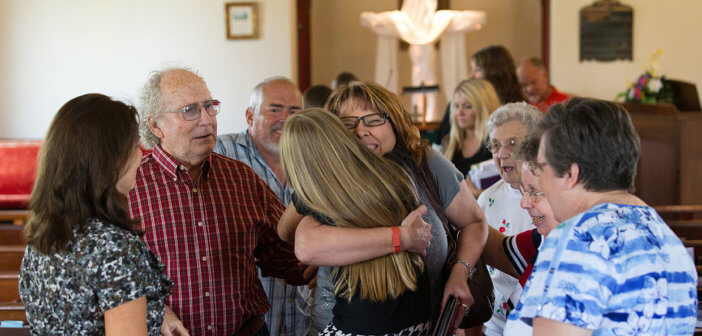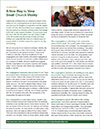Editor’s note: This information adapted from an article by Dr. Lewis A. Parks which appeared in Leading Ideas on October 14, 2015. This To the Point version has been edited for brevity and is accompanied by a PDF flier that you may download and share with others.
I spend my working days as a pastor trying to name reality for my congregation as we wind a precarious way between the heights of aspiration and the depths of self-criticism. We know that we are supposed to be the tree planted by streams of living water that brings forth fruit in due season (Psalms 1:3), but some days feel more like the tree given one last chance (Luke 13:8). We would sing the songs of hope but keep hitting sour notes like the loss of a critical mass of young adults or another expensive repair to our big old building.
We are not going to turn it around overnight. And we are not going to have to close in the morning. So where are we? And what are we going to do here? I have found it helpful to describe a dynamic equilibrium for this congregation and other small to mid-sized congregations I have served, and then to hold that condition before them as a measure of vitality. Dynamic equilibrium suggests that the congregation is a complex organism with staying power, but an organism with certain key indicators of health or decline.
The congregation maintains vital worship of God. There are contexts where maintenance is not a bad word and this is one of them. Season after season the People of God gather in this place to honor God with their praise and prayers, to attend to the word, to be exposed to the water, bread, and cup. The Spirit is already there making Christ present. A little cooperation with the Spirit on the part of those gathered, a little striving for excellence, a little freedom to express local religious creativity, and all things sprinkled with lots of hospitality will sustain the discipleship of the congregation throughout the week.
The congregation is a surrogate family. Terrell is one of the homeless persons who migrated from the weekday ministries to our worship service. He is known by name. He tells his stories of life on the road. He watches and imitates the steps of worship. He finds shelter and affirmation in the sanctuary. But is he really so different from others there? There are only a handful of multi-generational households present in our worship; most are single adults, single adults raising children, single adults caring for aging parents, or just single adults. So they too are looking for a place to be known by name, to share their hearts and their resources, and to be enveloped in the warmth of family-like ties.
The congregation is a blessing to the community where it finds itself. The social location of the church in its community may have changed. The demographics in a three-mile radius may be less than promising. The pastor and a good many members drive in from a distance. The chill winds of a fortress mentality blow around the building. Unless relocation is on the table, the congregation must summon energy for local extroversion. “But seek the welfare of the city where I have sent you into exile, and pray to the Lord on its behalf, for in its welfare you will find your welfare” (Jeremiah 29:7). The church that is in touch with the community narrative and incorporates its narrative into that one with well-targeted ministries has a future.
The congregation maintains its building for holy space and mission. I try to remember two things from the wonderful story of Francis of Assisi’s call from God in the dilapidated Church of St. Damian: “Do you not see that my house is in ruins? Go and restore it for me.” (1) It became a powerful metaphor for his life’s work. (2) He went back and repaired that building! A church in dynamic equilibrium attends to its properties. It appreciates the blank canvas for creative local expression it has been given. It addresses obstacles to hospitality, the creeping issues of safety, the upgrades that would improve ministry and mission.
The congregation passes the faith to the coming generations. From God’s promise of descendants to Abram and Sarai, to Paul’s coaching of Timothy, the Bible clearly favors an intergenerational faith. “One generation shall laud your works to another,” says the Psalmist (145:4). If I would place one element slightly above the others it would be this. If you have ever known someone who was the last person in their family line, you know the threat presently experienced in many smaller congregations. Grandparents bring three quarters of our children. And we rarely have enough children present at one time for group activity. Still we must attend to the children we have, calling them by name, teaching the faith with a one-room-school model, encouraging their active participation in the worship.
There are other worthy dramas for congregations besides “grow bigger.” One is sustaining a dynamic equilibrium by applying pressure to key points of vulnerability of this Spirit-animated organism.
Lewis Parks is Professor of Theology, Ministry and Congregational Development at Wesley Theological Seminary. He pastors Calvary United Methodist Church in Lemoyne, Pennsylvania, assists denominational leaders around vitality in small churches and is author of several books, including Small on Purpose: Life in a Significant Church (Abingdon Press, 2017), available at Cokesbury and Amazon.






